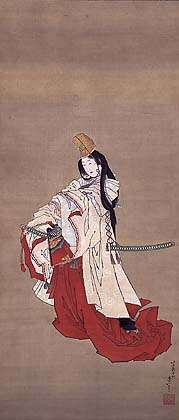Shirabyōshi

Shirabyōshi (白拍子) were female dancers, prominent in the Japanese Imperial Court, who performed traditional Japanese dances (the dances themselves were also called shirabyōshi). They danced dressed as men. The profession of shirabyōshi developed in the 12th century. They would perform for the nobility, and at celebrations.
They are sometimes referred to as courtesans in the English language, but that term refers to a high-class prostitute, so this is rather incorrect. By nature they were performers. Some shirabyōshi did sleep with their patrons and give birth to nobles' children, but this was not their intended purpose as entertainers.
History
Shirabyōshi came about in the late Heian period. It was a time of cultural change, so in order for some women to survive they turned to performing. After their inception, Japan experienced a shirabyōshi boom in which many women became shirabyōshi because of their popularity. A shirabyōshi was always a woman who dressed in men's attire, performing dances for the gods. The name shirabyōshi meant "white rhythm", partly because of their make-up, and because their songs were slow and rhythmic. They were required to be educated, including being able to both read and write—they were talented poets, musicians, singers, and dancers.
It has been said that the shirabyōshi culture greatly influenced Noh drama by bringing forth kusemai, an unorthodox form of dancing, and introducing it to Noh.
Attire and appearance
Shirabyōshi were recognizable for the outfit they would wear, which was Shinto-inspired. It truly was a man's outfit, as it featured:
- A tate-eboshi hat, worn by samurai
- A tachi, a samurai's sword
- Red hakama, worn primarily by men
- White suikan and red suikan, a male Shinto outfit
- A kawahori hand fan, which men carried
Shirabyōshi wore the trademark white facial make-up that would centuries later come to be associated with geisha, completely covering their face and neck and painting new eyebrows higher on the forehead. Their hair was rather simple: it was long (sometimes nearly to the floor) and pulled back into a loose ponytail secured with a ribbon called a takenaga.
Music
Shirabyōshi songs were mostly based on Buddhist prayers. The songs were usually slow and rhythmic, with great meaning in the words. They also would sing imayo songs, which were poems using images of nature to convey meanings of circumstances in their lives. Trademarks of their music included their voices, the drum and the flute.
Famous shirabyōshi
Shizuka
Shizuka, commonly referred to as Shizuka Gozen, was the concubine and lover of Minamoto no Yoshitsune, the tragic hero of many folk legends. She was possibly born in 1168, and is popular in folk legends herself. She and Yoshitsune met and fell in love, but by the time she had become pregnant, Yoshitsune was on the run for his life. She was captured and taken to the Shogun, Minamoto no Yoritomo in Kamakura, Yoshitsune's older brother. There she gave birth to a son, who was, according to some versions of the tales, promptly killed by his uncle Yoritomo, but survived in others.
In some tales Shizuka was then forced to perform a dance for Yoritomo and his wife Hōjō Masako at a temple celebration, where she sang a song of praise for her love Yoshitsune. This greatly angered Yoritomo, and he intended on having her put to death but Masako begged for her life. Shizuka was freed and sought to follow Yoshitsune, but she learned of his death. She became a nun and died in 1189. Her song is famous and is still sung today by geisha.
Giō and Hotoke
The story of Giō and Hotoke, featured in the Heike Monogatari, is long and involved, but basically tells of the most famous shirabyōshi Giō, who had won the heart of Taira no Kiyomori, being ousted by a younger and more talented shirabyōshi named Hotoke. Kiyomori cruelly sent Giō away, which grieved her greatly, and Hotoke was constantly ridden with guilt. A year later, Giō was asked to perform a dance for Hotoke at Kiyomori's command, who actually intended on humiliating her. In her grief and humiliation, Giō, her sister and their mother became nuns seeking for a happier life. A few years later, the guilt was too great for Hotoke and she too became a nun. She asked for forgiveness from Giō, who willingly forgave her and the four women lived out the rest of their days in prayer.
External links
| Wikimedia Commons has media related to Shirabyōshi. |
- Hokusai Museum
- Examining a shirabyoshi outfit
- A brief explanation of shirabyoshi
- Shirabyoshi: Japanese dancers
- Shizuka Gozen's story
- Gio's story
- Japan print gallery: shirabyoshi
- Shirabyoshi on Immortal Geisha